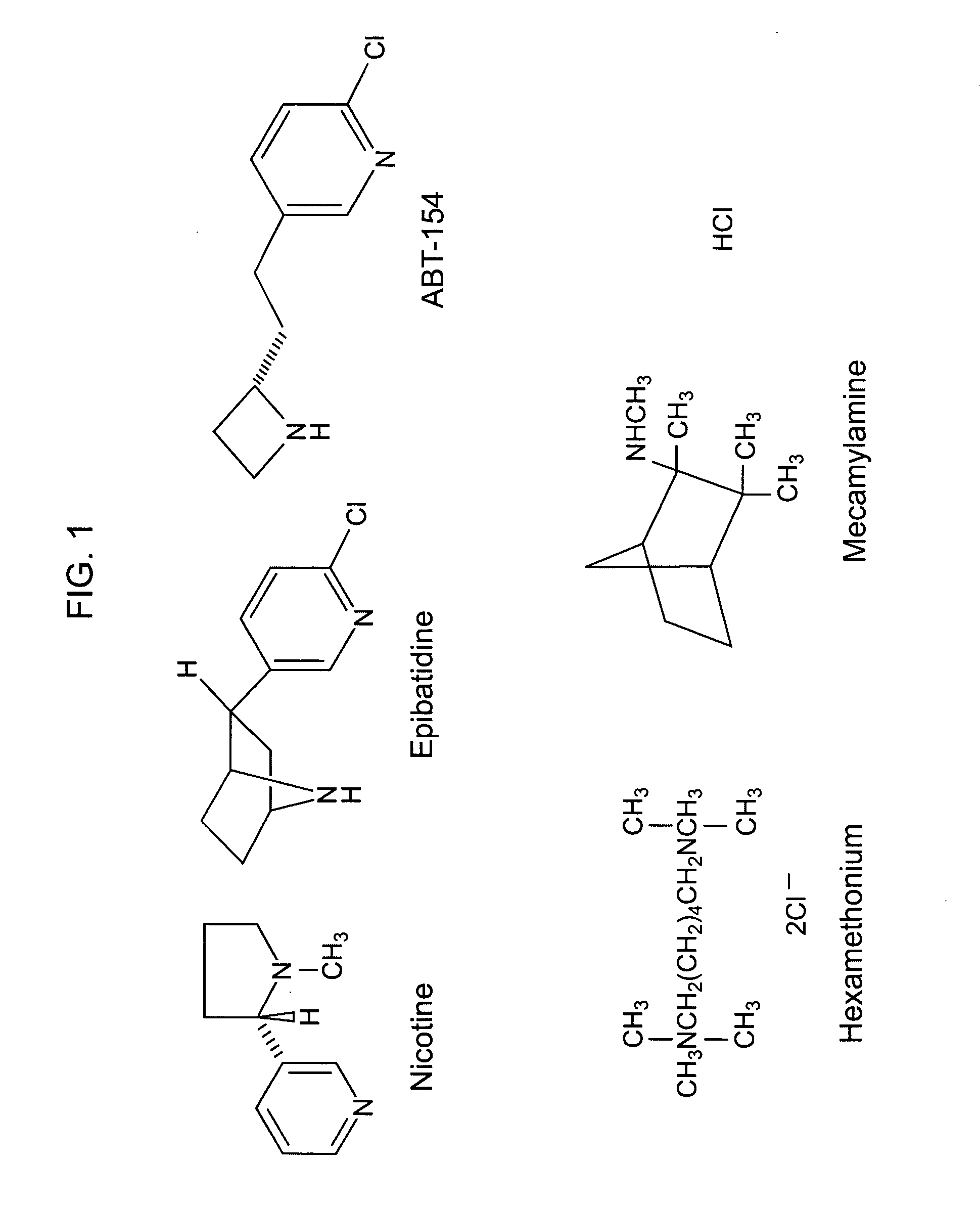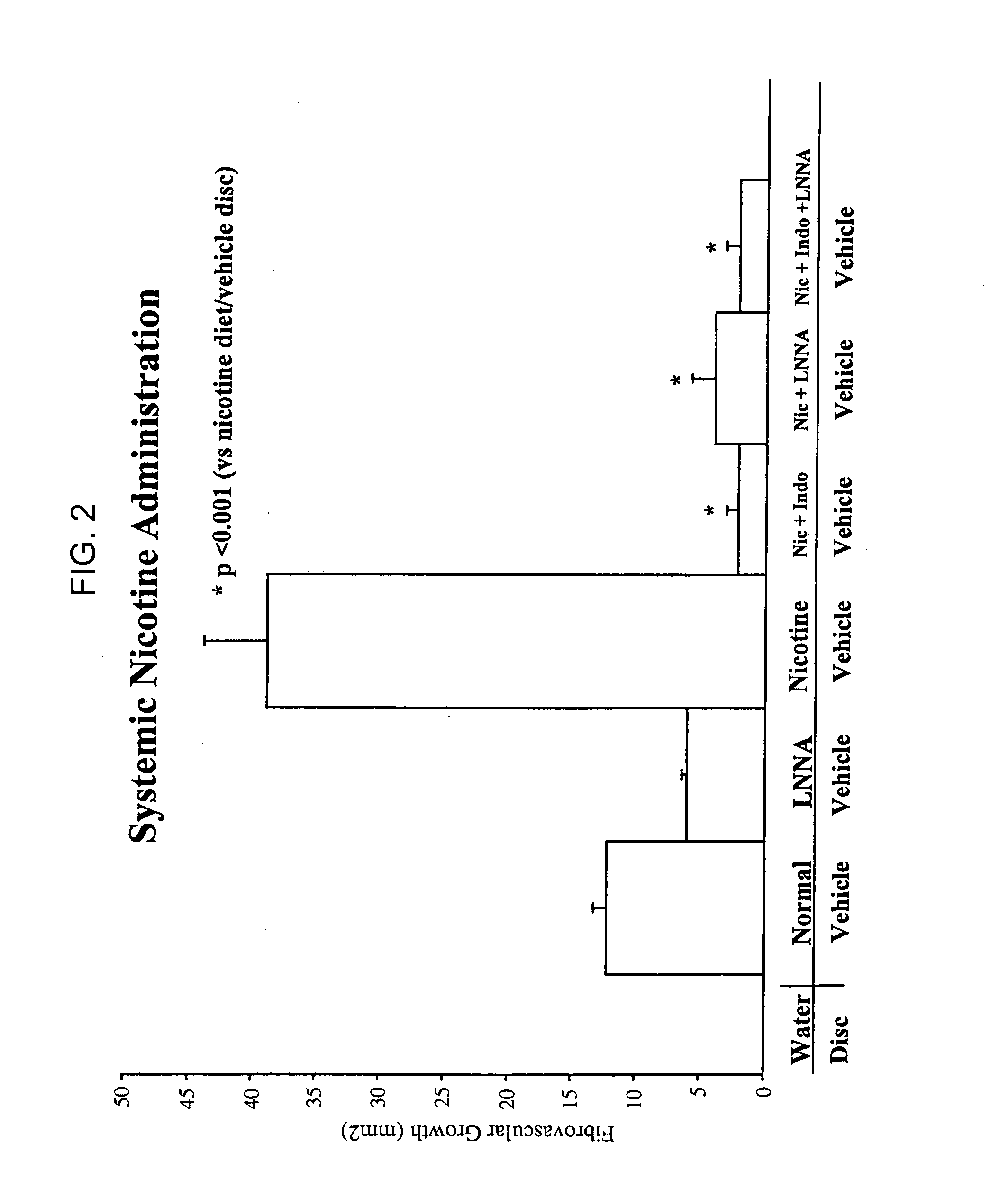Nicotine receptor agonists in stem cell and progenitor cell recruitment
a technology of nicotine receptor and stem cell, applied in the field of stem cell and progenitor cell mobilization and recruitment, can solve the problems of limited therapeutic applicability of some of these compounds, especially as systemic agents, and achieve the effect of increasing fibrovascular growth
- Summary
- Abstract
- Description
- Claims
- Application Information
AI Technical Summary
Benefits of technology
Problems solved by technology
Method used
Image
Examples
example 1
Systemic Effect of Nicotine Upon Angiogenesis in Vivo
[0142] To study the effects of nicotine in systemically treated mice, nicotine (60 mcg / ml, n=5) was diluted in the drinking water. The mechanism of nicotine-induced angiogenesis was studied by giving oral supplementation of indomethacin (20 mcg / ml, Sigma, n=5) and / or LNNA (6 mg / ml, Sigma, n=5) to mice having an implanted DAS both locally treated (nicotine inside the DAS) and systemically treated (nicotine diluted in drinking water). Concentrations of nicotine, indomethacin, and LNNA were determined in accordance to studies using oral supplementation of these agents in murine models (Maxwell et al. (1998) Circulation 1998 98(4):369-374; Fulton et al. (1980) Int J Cancer 26(5):669-73; Rowell et al. (1983) J Pharmacological Methods 9:249-261).
[0143] Under basal conditions (untreated water, vehicle-treated disc), fibrovascular growth into the disc occurred. Vessels could be seen growing into the disc. These vessels were in continuit...
example 2
Local Effect of Nicotine Upon Angiogenesis in Vivo
[0144] In order to determine if local administration of L-arginine could be effective at inducing angiogenesis, in some animals, nicotine was placed within a pellet that was inserted into the disc angiogenesis system (described above). When nicotine was placed in the disc (rather than administered in the water of the animals as described in Example 1) a similar effect was observed. The fibrovascular growth under basal conditions (about 10 mm2) was increased to about 20 mm2 (FIG. 3). Again, indomethacin or LNNA blocked the effects of nicotine. These studies indicate that systemic or local administration of nicotine induces angiogenesis.
example 3
Comparison of Effects of Nicotine with Other Angiogenic Agents
[0145] The effects of nicotine were compared with the angiogenic agents bFGF and Dell. The comparison with bFGF is particularly important because this agent is already in clinical trials in humans for therapeutic angiogenesis. In comparison to vehicle, bFGF, Dell, and nicotine each increased angiogenesis to the same degree. Systemically administered nicotine enhanced angiogenesis to a much greater degree than locally administered bFGF and Del-1 (FIG. 4). Paradoxically, the effect of systemic nicotine administration was greater than local nicotine administration, even though systemic nicotine administration undoubtedly produced lower local levels in the disc. This paradox led the investigators to consider that the systemic administration of nicotine was inducing vasculogenesis (recruitment of endothelial precursors from the bone marrow) as well as local angiogenesis (see Example 5 below). Intermediate doses of nicotine ad...
PUM
| Property | Measurement | Unit |
|---|---|---|
| time | aaaaa | aaaaa |
| time | aaaaa | aaaaa |
| time | aaaaa | aaaaa |
Abstract
Description
Claims
Application Information
 Login to View More
Login to View More - R&D
- Intellectual Property
- Life Sciences
- Materials
- Tech Scout
- Unparalleled Data Quality
- Higher Quality Content
- 60% Fewer Hallucinations
Browse by: Latest US Patents, China's latest patents, Technical Efficacy Thesaurus, Application Domain, Technology Topic, Popular Technical Reports.
© 2025 PatSnap. All rights reserved.Legal|Privacy policy|Modern Slavery Act Transparency Statement|Sitemap|About US| Contact US: help@patsnap.com



